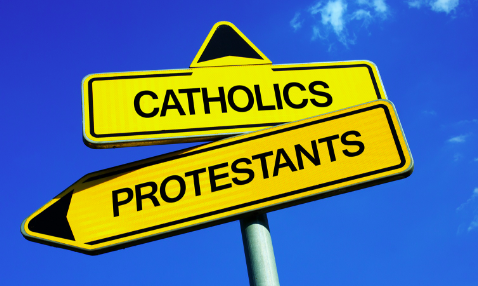Catholicism and Protestantism are two major branches within Christianity that originated from the 16th-century Protestant Reformation. While both groups share core Christian beliefs, there are significant theological, historical, and practical differences between them. Here are some key distinctions:
- Authority:
- Catholicism: The Roman Catholic Church believes in the authority of the Pope, who is considered the successor of St. Peter and the Vicar of Christ on Earth. The Church also upholds the authority of tradition and the teachings of church councils alongside the Bible.
- Protestantism: Protestants emphasize the authority of the Bible alone (sola scriptura) as the sole infallible rule of faith and practice. They reject the Pope’s authority and emphasize individual interpretation of Scripture.
- Salvation:
- Catholicism: Catholics believe that salvation is achieved through faith in Jesus Christ, participation in the sacraments, good works, and cooperation with God’s grace. They also believe in the concept of purgatory—a temporary state after death where souls undergo purification before entering heaven.
- Protestantism: Protestants generally emphasize salvation through faith alone (sola fide) in Jesus Christ. They reject the necessity of good works for salvation and do not recognize the concept of purgatory, emphasizing instead the assurance of salvation through faith.
- Sacraments:
- Catholicism: The Catholic Church recognizes seven sacraments, including baptism, confirmation, the Eucharist, reconciliation (confession), anointing of the sick, holy orders, and matrimony. They believe these sacraments convey God’s grace to believers.
- Protestantism: Protestants generally recognize only two sacraments: baptism and the Lord’s Supper (or Communion). Some denominations may have fewer sacraments or view them symbolically rather than as means of conveying grace.
- Church Structure and Worship:
- Catholicism: The Catholic Church has a hierarchical structure with the Pope at the top, followed by bishops, priests, and deacons. The Mass is the central form of worship, emphasizing liturgy, rituals, and sacraments.
- Protestantism: Protestant churches vary in structure, but many emphasize congregational autonomy and local church governance. Worship styles and practices can vary significantly among Protestant denominations, ranging from formal liturgical services to more contemporary styles.
- Beliefs and Practices:
- Catholicism: Catholicism places importance on veneration of saints, the Virgin Mary, and tradition, including the use of religious icons and statues in worship. They uphold certain doctrines like transubstantiation (belief that the bread and wine in the Eucharist become the actual body and blood of Christ).
- Protestantism: Protestants generally do not venerate saints or religious icons to the same extent as Catholics. They emphasize a personal relationship with Jesus Christ and may have varied views on doctrinal issues like the nature of the Eucharist, predestination, and the role of good works.
These differences highlight some of the key theological and practical distinctions between Catholicism and Protestantism. However, it’s essential to recognize that both groups share a foundational belief in Jesus Christ as Savior and Lord, even though they may interpret certain aspects of Christian doctrine and practice differently.
Share this:
- Click to share on X (Opens in new window) X
- Click to share on Facebook (Opens in new window) Facebook
- Click to share on Reddit (Opens in new window) Reddit
- Click to share on LinkedIn (Opens in new window) LinkedIn
- Click to share on Pinterest (Opens in new window) Pinterest
- Click to share on Telegram (Opens in new window) Telegram
